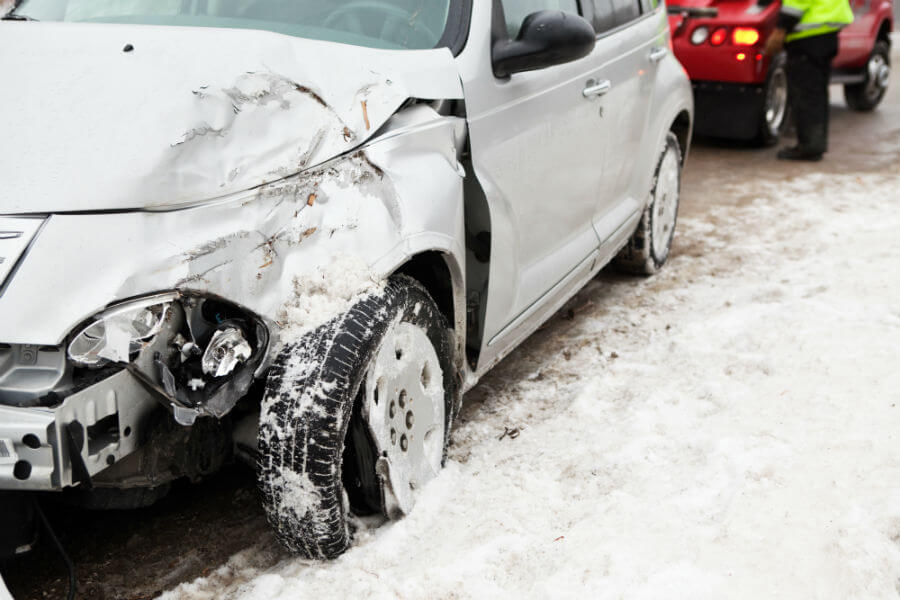Ohio car accident attorney –
Ohio has the most incidences of deadly winter car crashes.
From 2011 to 2015, there were more than 420 fatalities in Ohio due to winter car accidents. The top five deadliest states for winter car crashes are all in the Upper Midwest or near the Great Lakes. (USA Today)
Taking a look at most winter driving statistics, it becomes evident that storms, snow, rain, fog, and icy roads represent a huge traffic hazard. Our main goal is to make people aware of the dangers that come with winter driving, but also to help everyone stay safe. That’s why we also compiled a list of some useful tips on winter driving.
The Winter Driving Statistics You Must Know
- Over 70% of US roads are in snowy regions.
- About 70% of the US population lives in snowy regions.
- 17% of all vehicle crashes happen in winter conditions.
- 1,836 people die annually due to snowy and icy pavement.
- There are 156,164 crashes annually due to icy roads.
- More than 1,300 people are killed in car crashes on snowy or icy roads every year.
- Over 116,800 people get injured in car accidents on snowy or icy roads every year.
- Every year, about 76,000 people are injured in traffic accidents during snowfall.
- About 70% of accidental fatalities that occur during winter happen in cars.
- 800 Americans die in car crashes annually while driving in winter weather conditions.
Winter Driving Tips
Considering how many car accidents occur in winter weather conditions, let’s focus on some safety rules and practical tips for driving in adverse weather.
Prepare Your Vehicle
- Check that your tires are properly inflated and have enough tread.
- Test your vehicle’s battery.
- Have at least half a tank of fuel at all times.
- Prepare cold-weather gear, such as a flashlight, a glass scraper, and blankets.
- Bring important medications, extra food and water, and warm clothes.
Drive Carefully
- Adjust your speed to road conditions and weather.
- Don’t use cruise control on slick pavement.
- Accelerate slowly to avoid skids.
- If you have antilock brakes (ABS), you can apply steady pressure to the brake pedal. If you don’t, pump your brakes to prevent your wheels from locking up.
- Increase your following distance on the road.
People Also Ask
Are there more car accidents in the winter?
Although the winter driving statistics prove that cold weather is highly unfavorable for driving, there are more car accidents during summer. One possible explanation for this is that roads are more often heavily congested during summertime. In addition, there’s more road construction, which increases the risk of traffic accidents.
What are the three key elements to safe winter driving?
Besides the regular driving safety tips that you should follow, our winter driving facts suggest some straightforward steps worth taking. First, it’s vital to make sure your vehicle is in the right shape for winter driving. Also, always adapt your speed to the road and weather conditions. Last but not least, if possible, avoid driving when the conditions are particularly hazardous.
How much should one reduce their speed when driving on snow?
When driving on snowy or icy roads, it can take up to 10 times longer to stop. Therefore, you should reduce your speed by about 30% when driving on wet pavement and by at least 50% on roads covered with snow.
Winter Driving Accident Statistics
-
Over 70% of US roads are in snowy regions.
On average, these regions receive more than 5 inches of snowfall annually. Considering that snow and sleet make roads slicker and reduce visibility, there’s an increased risk of traffic accidents in these regions.
(The Federal Highway Administration)
-
About 70% of the US population lives in snowy regions.
Since snowy weather can greatly obstruct driving, a huge portion of the population has a higher risk of crashing their car during the winter.
(The Federal Highway Administration)
-
17% of all vehicle crashes happen during winter conditions.
This is a clear sign that people don’t take driving in winter conditions seriously enough. Besides driving carefully, drivers should also prepare their vehicles for the harsh winter weather.
(National Highway Traffic Safety Administration)
-
According to winter driving accident statistics, traffic accidents on snowy, slushy, or icy roads account for 24% of weather-related traffic accidents.
In addition, 15% of the traffic accidents caused by bad weather occur during snowfall or sleet.
(The Federal Highway Administration)
-
1,836 people die annually due to snowy and icy pavement.
This is the 10-year average for 2005–2014. In addition, 136,309 people are injured annually because of snowy and icy roads.
(Icy Road Safety)
-
More than 1,300 people get killed in car crashes on snowy or icy roads every year.
This shocking fact should serve as a reminder that it’s vital to drive carefully at all times, especially in adverse weather conditions.
(The Federal Highway Administration)
-
About 76,000 people get injured in traffic accidents during snowfall each year.
In addition, according to the winter driving statistics in the USA, over 800 people die in car accidents during snowfall or sleet.
(The Federal Highway Administration)
-
Over 116,800 people get injured in car accidents on snowy or icy roads every year.
When pavement’s slick, drivers can easily lose control of their vehicles, which results in a huge number of traffic accidents every year.
(The Federal Highway Administration)
-
About 70% of the accidental fatalities that occur during winter happen in cars.
Therefore, winter weather poses the greatest danger to people traveling by car.
(The Zebra)
-
Based on the 10-year average from 2007 to 2016, there were 156,164 crashes annually due to icy roads.
And according to data from the 2008–2010 period, fatal crashes due to icy roads are most likely to occur in the Midwestern and Plains states. However, they can even happen in the deep South.
(The Federal Highway Administration)
-
These winter driving accident statistics also indicate that an average of 800 Americans die in car crashes annually due to winter weather conditions.
This figure represents the average for the period of 2011 to 2015. The car wrecks were caused by freezing rain, snow, sleet, or ice.
(USA Today)
Summer Driving vs. Winter Driving Statistics
-
December has the most traffic fatalities in winter.
According to a NHTSA study covering a period of 24 years, December is the month with the highest number of traffic fatalities among the winter months.
(National Highway Traffic Safety Administration)
-
August has the highest number of traffic fatalities overall.
According to the same study, August is the deadliest month when it comes to traffic accidents. It’s followed by July, October, June, and September. Considering these winter driving facts, it comes as a surprise that there aren’t any winter months among the top five deadliest ones.
(National Highway Traffic Safety Administration)
-
Summer months have 29% more deaths in car crashes than winter months.
Although this seems counterintuitive, there are more traffic fatalities in June, July, and August than in December, January, and February. However, this can be easily explained by the fact that there are more vehicles on the roads during the summer months. After all, it’s usually the best time to go on a road trip.
(National Highway Traffic Safety Administration)
-
Teenage drivers are at the highest risk of deadly car accidents in July and August.
This is the period when most teenage and student drivers are on the roads since they’re on their summer break. In addition, they have less driving experience than older drivers, which makes them more prone to car accidents.
(HuffPost)
-
20% more miles are driven in the summer months than in the winter months when comparing summer and winter driving statistics.
As a result, there are more people on the roads, which increases the risk of car accidents.
(National Highway Traffic Safety Administration)
-
Independence Day has the highest number of traffic fatalities.
Generally, holidays carry a greater risk of traffic fatalities since more people are on the road than usual. Therefore, drivers should be particularly careful when driving during the Christmas holidays, Independence Day, Memorial Day, and so on.
(National Highway Traffic Safety Administration)
-
On average, there are 358 traffic deaths during the Memorial Day period.
This figure represents a six-year average, and it accounts for about 11% of the total number of traffic deaths in May.
(Injury Facts)
-
There’s an increased risk of blowouts in hot weather.
Drivers should regularly check their tire air pressure since improperly inflated tires can lead to a blowout in high heat. According to the NHTSA, there were 738 traffic fatalities in 2017 due to tire problems.
(HuffPost)
These winter driving tips are based on the more common risks that winter driving conditions produce, so they should help reduce your risk of having a car accident.
Conclusion
Whenever you’re behind the wheel, you should stay alert at all times and keep your eyes on the road. In adverse weather conditions, this is even more important. We compiled these winter driving statistics to make you aware of how deadly snowy and icy roads can be and to remind you that you should take winter driving seriously. Hopefully, our tips will help you steer clear of car accidents and enjoy your ride. Drive safely!
You Have Been In An Accident In Ohio, Contact An Experienced Ohio Accident Law Firm For A FREE Evaluation
If you or a loved one were injured on the road and you’re looking for a Ohio car accident attorney that will guarantee the caring, personalized and loyal representation you deserve, please do not hesitate to contact Wright & Schulte LLC today. The Wright & Schulte LLC team of Ohio accident lawyers can aid in achieving the result that is best for you. When cases must be tried, few can match Wright & Schulte LLC’s extensive courtroom experience. Ohio state law sets a two-year statute of limitations for lawsuits regarding personal injury, medical expenses, pain and suffering, lost wages and property damage, so it’s important to act quickly. For a free, no obligation legal evaluation of your case, simply fill out the online form on the right, or give Wright & Schulte LLC a call or text us, at (937)-222-7477.



